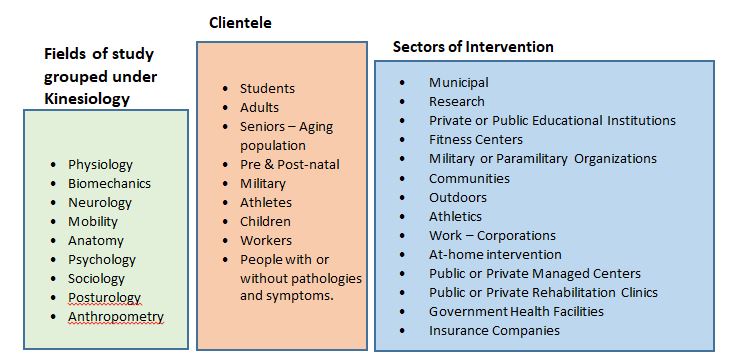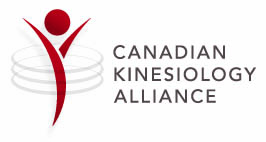Differences between Kins, EP and AT
The three professions of Kinesiologist, Exercise Physiologist and Athletic Therapist are becoming more distinct and differ from one another by their scope of practice, their educational requirements for certification and their recognition by legal authorities and/or other organizations.
Here is an attempt in summarizing the differences between the professions and their organizations.
Disclosure
The information may differ from one province to another. The primary purpose is to provide information. As kinesiology is provincially legislated, the information may different from one province to another. The CKA / ACK is not responsible for consequences and damages that may occur as an outcome of its use or misuse, incomplete use and mis adaptation, and its interpretation by anyone. It is to be stressed that the aim is to guide and if anyone has difficulty over interpretation, they should seek independent advice.
Kinesiology is the study of the dynamics[1] of human movement, and its components (anatomical, physiological, neurological, biochemical, biomechanical, neuromotor, psychological) in interaction with the environment.
In simpler terms, we can say that kinesiology is also defined as human kinetics or the scientific study of human movement. The term comes from the Greek word "kinesis" which means "to move".
Kinesiology consists of several fields of study (see the following diagram) which, in their own right, could each form an independent profession (e.g., physiologist, biomechanist, neurologist, etc.). In Canada, we have chosen to group together these different professions, that focus on all aspects of human locomotion.
Kinesiologists
As University-educated health professionals, Kinesiologists apply exercise and movement science to promote health and wellbeing; prevent, manage and rehabilitate injuries; treat illness and chronic disease; restore function, and optimize human performance in the workplace, clinical settings, sport and fitness. Kinesiologists are the only human movement specialists that use science and research to offer movement as medicine to any person with a health or fitness goal, who want a hands-on, personalized approach. Kinesiologists work with people of all ages, and physical abilities, in many settings, to help them achieve their health and wellness goals. They improve quality of life, often using interventions that include physical activity.
THE DIFFERENT TITLES

Kinesiologists:
The title of a Kinesiologist may differ from province-to-province. The use of the title “Kinesiologist” with a qualifier exists because PKAs are bound by their Bylaws or Provincial Laws. The CKA encourages us to use the term “Kinesiologist” (without any qualifiers) where possible. In Canada, Ontario is the only province that legally requires the use of the title “Registered Kinesiologist”.
In addition, there are several professional labels that may sound similar to a Kinesiologist but do not mean the same thing. The titles are becoming more numerous. As a profession, we must be vigilant with regards to the quality of the education, and training, received and the nature of the services provided. Some similar titles include:
Exercise Physiologist:
Although in some Canadian provinces there may be differences in education and in the distinction of terminology, for the CKA, physiology is one of the fields that are integrated into kinesiology. However, it can be the subject of a specialization in the field of kinesiology in the same way as biomechanics, motor skills, anatomy, etc. One may say that Exercise Physiologists are specialized Kinesiologists that do not perform the entire scope of practice.
Athletic Therapist:
In Canada, a Certified Athletic Therapist (CAT (C)) is a healthcare professional who specializes in emergency care and in the prevention, identification, intervention and management of injuries or musculoskeletal conditions, particularly in athletes. This includes acute or chronic musculoskeletal conditions of varying origin. One may say that Athletic Therapists are specialized Kinesiologists that do not perform the entire scope of practice.
Kinesiologist-kinesiotherapist:
A Kinesiologist-kinesiotherapist is not recognized by CKA due to the wide gap in the profession’s standards of practice. The definition of kinesiologist-kinesiotherapist is as follows [1]:
"Kinesiology-kinesiotherapy is part of a therapeutic treatment framework based on a principle of muscle rebalance with the active participation of the subject in their treatment.
After a personalized clinical observation including visual exams, palpation and mobilization, the kinesiologist-kinesiotherapist will practice
- Therapeutic massage care with active participation of the subject
- Gentle mobilization maneuvers respecting physiological amplitudes
- Exercises education to achieve musculoskeletal balance for better posture
- Personalized exercise program to avoid relapses
- Therapeutic follow-up to counter the recurrence of musculoskeletal discomfort
- Participate in a multidisciplinary follow-up in association with other members of the healthcare field to ensure optimal patient care”
The term kinesiotherapist is the name for a physiotherapist in France and the practice is similar.
Applied kinesiology :
We must not confuse kinesiology with Applied kinesiology, which are two similar titles, but whose methods of practice are very different. Our profession is based on recognized scientific data while Applied kinesiology has an esoteric base focused on balancing energy pathways.
Kinesiologists
As mentionned, Kinesiologists work with people of all ages, and physical abilities, in many settings, to help them achieve their health and wellness goals. They improve quality of life, often using interventions that include physical activity. See below for a summary diagram:

Kinesiology interventions are varied and target all Canadians, regardless of age or whether or not they are affected with health problems. Target populations include:
Asymptomatic population (without symptoms or pathology):
- Adults in general, including pregnant women
- Specific clienteles (e.g., paramilitary and military services, workers, astronauts, etc.)
- Athletes and adventurers
- Children and adolescents
- Students (teaching, scholarship athletes (e.g. ‘’Sports-études’’ programs))
- Seniors and aging populations
Symptomatic and special populations with clinical conditions:
- Metabolic conditions
- Cardiovascular conditions
- Pulmonary conditions
- Neurological conditions
- Musculoskeletal problems
- Mental health and psychiatric diagnoses
- Other conditions (e.g., chronic pain, sensory disorders, etc.)
The health, and physical activity, needs of any population are multifactorial. Therefore, an interdisciplinary and collaborative approach provides a population with a higher quality of service. Kinesiologists frequently collaborate with other health professionals to provide multidisciplinary and interdisciplinary interventions for prevention, treatment, and performance.
They occasionally contribute to the evaluation with the medical team and are involved in creating a treatment, or intervention, plan.
The kinesiologist complements other healthcare professionals through their wide range of knowledge and broad scope of practice. Here are some examples of what a kinesiologist brings to the treatment team:
- Kinesiologist – provide prevention, promotion, treatment and rehabilitation services in various health facilities including mental health clinics and private clinics.
- Kinesiologist – trained in neuromusculoskeletal and functional evaluation
- Kinesiologist – trained in ergonomics for workplace and occupational health
- Kinesiologist – coach and fitness trainer for high performance
- Kinesiologist – promoter of public health
- Kinesiologist – clinical manager and coordinator
- Kinesiologist – case manager for insurance companies
- Kinesiologist – personal trainer and physical conditioning coach
- Kinesiologist – researcher
- Kinesiologist – lecturer and instructor
- Kinesiologist – teacher
- Kinesiologist – performing all other actions targeting the promotion of physical activity and the adoption of a healthy and physically active lifestyle
Kinesiology is an evolving profession. Kinesiologists adapt to the changing demands of their clients’ needs.
Complementary Training or Specializations
Although the primary mandate of the CKA is to promote kinesiology across Canada, we acknowledge that the initial bachelor's degree for our profession may be used as the basis for further training, specializations or may be a step to a professional practice other than kinesiology. It is important to be trained appropriately to gain the right to practice in one’s province, especially if certain treatment modalities are regulated. In some provinces, some modalities may be reserved to another healthcare profession.
Before practicing, the CKA recommends that you speak with your Provincial Kinesiology Association to determine if you are legally allowed to perform certain services:
- In some provinces, additional training in kinesiology may lead to other therapeutic services such as occupational therapy. In other provinces, occupational therapy may be supervised by a professional order and requires specific and exclusive training. Certain acts are regulated and can exclusively be done by the occupational therapist in their field of practice, which are predefined by legislation. Using the title of occupational therapist/ergotherapist in that province or executing professional acts that are not permitted without being a member of the order can lead to criminal prosecution
- In some provinces, the Provincial Kinesiology Association may restrict the scope of practice. For example, a kinesiologist who
wants to apply osteopathic techniques may need the legal title of Osteopathic Manual Practitioner.. Also, a kinesiologist may not be able to use manual therapy techniques in some provinces. In other provinces, this may not be the case.
[1] The website for the association of kinesiologists, physiotherapists, orthotherapists and massage therapists of Quebec (AKKOMQ),
[1] Dynamic theory adopts a more radical point of view, assuming that the behavior of a complex system emerges from a network of constraints, related either to the task, the organism, or the environment (Newell, 1986). Adapted by CKA from : La théorie dynamique adopte un point de vue plus radical, postulant que le comportement d'un système complexe émerge d'un réseau de contraintes, liées soit à la tâche, soit à l'organisme, soit à l'environnement (Newell, 1986).
Although kinesiology is much broader than exercise physiology, here are two documents highlighting that exercise physiology is an integral part of the field of kinesiology: Differences between Kinesiologist and Exercise Physiologist under CSEP as per recognition by EIMC:
Scope of practice and EIMC CEP designation
Differences between Professional Insurance Coverage offered by CKA/PROLINK, CSEP, CATA and Kinsurance.ca


